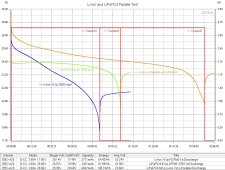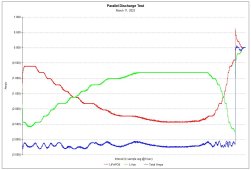OK I try to outline what will happen
- charge all up to 29,2V (3,65 x 8 = 4,17 x 7)
- Relaxing cells. LFP drops to 3,4-3,45V/cell = 27,2V
- NMC relax V I am not sure, lets say 4,1V/cell = 28,7V
- There is already 1,5V difference, NMC will overcharge LFP
- start to discharge it.
- LFP drops fast (like 2-5% discharge) to 3,3V/cell = 26,4V
- NMC does not drop, lets say 4V = 28V
- Here is again a 1,6V difference. Both will discharge, but NMC will discharge faster
- 95% NMC 4V -> 28V
- 95% LFP 3,3V -> 26,4V ... NMC discharges faster
- 50% NMC 3,8V -> 26,6V
- 50% LFP 3,25V -> 26V ... they are coming closer
- 10% NMC 3,5V -> 24,5V
- 10% LFP 3,15V -> 25,2V ... now it reversed and LFP discharging faster
- 5% NMC 3,2V -> 22,4V
- 5% LFP 2,9V -> 23,2V ... LFP discharging faster
- If no load and stays here then LFP charging NMC
(I am too tired now to check the charge diagrams too

)
I see it working only if you remain in the 20-80% SoC part. That is only 60% usable capacity.
First NMC will discharge faster than LFP will discharge faster ... if constant load. If not they start to charge each other (causing extra wear)
)





